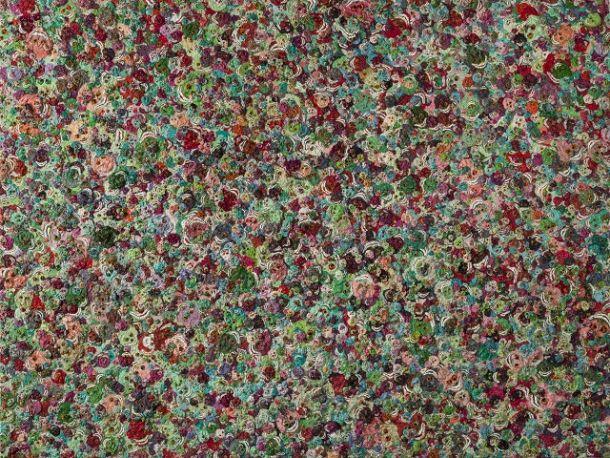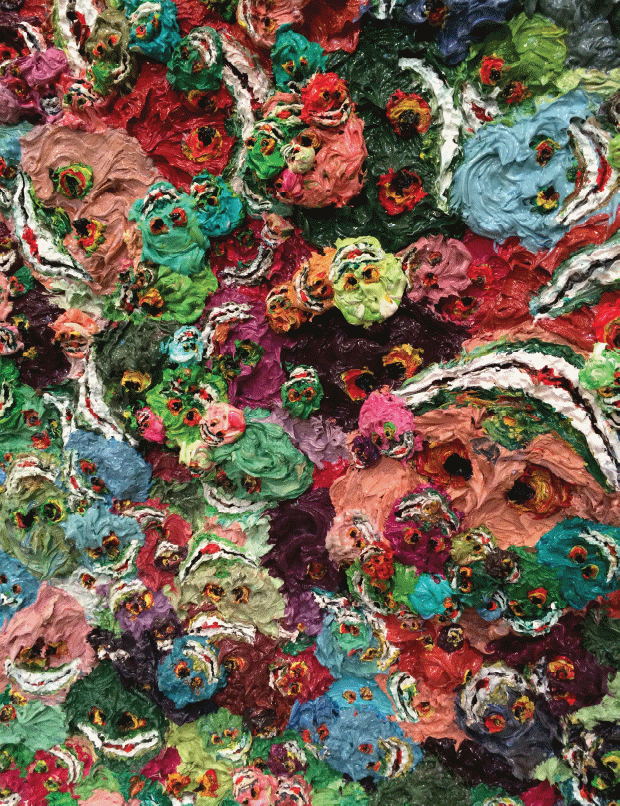General information on Zhang Huan’s series Poppy Fields
Zhang Huan is one of the most controversial and bodacious contemporary artists. His Poppy Fields series, presented in the Pace Gallery, is inspired by his visit to Tibet and, in particular, by Buddhist masks. The gallery describes the concept of these paintings in the following way, “these all-over paintings reference the history of China from ancient Buddhist dance masks to the hallucinatory imagery of opium smokers and the cultural revolution”1. If one looks at them from a distance, the paintings seem to be just a mesh of colors, but in reality, the canvases’ surfaces are “covered with hundreds of skulls … that look like grinning faces with bulging eyes and Cheshire cat smiles”2.
Observations and analysis of Poppy Field No 12
Poppy Fields vary in palette significantly, and each of them presents a unique piece of art with not only its own set of colors but with its own unique implied ideas. Poppy Field No. 12 is the painting that attracted my attention by vivid colors that were used to create them burgundy, red, blue, light green, and dark green; all of them are intermingled in this Poppy Fields, and all together resemble a bright carpet. This canvas presents a great contrast to other works painted by him that are black and white with hues of grey. This one is a “riotous festival of clashing colors.”3 From a large distance, it looked as if a canvas that was simply covered with big dots of different colors. At first, it seems that the author just squeezed some paintings and then did not lift a finger to use an artist’s pencil. Nevertheless, even from distance, it looks quite dramatic, and I had the impression that it pulsated with energy. Upon closer inspection, one may discover that the canvas depicts a multitude of faces and each one is unique. Some faces are bigger, some are smaller, some of them are right side up, and some are upside down. As to their facial expression, they are all grinning.
Zhang used a thick impasto technique in this painting. It is oil on linen, painted with the help of simple repetitive gestures. The size of the canvas is quite big – 150 cm x 200 cm.
If one tries to search for the sources of his inspiration aside from abovementioned Tibetan dance masks, one can come to the following conclusion, “skulls are a recurring image in Zhang Huan’s work and stem from the artist’s early explorations in performance, inspired by the body and human form”4.
Zhang Huan disclosed the meaning of his art, and particularly, of this series in several interviews declaring that these “paintings represent the hallucination of happiness and the hallucination of fear and loneliness in this life as well as the hallucination of happiness in the next life.”5 This very canvas was, most likely, created to show the hallucination of happiness, not the hallucination of fear or other negative feelings he thrived to depict, as all the faces are smiling, unlike the skulls from Poppy Field No. 14. It is interesting to learn what particular event made him feel this hallucination of happiness projected in this painting:
He … witnessed the Tibetan sky burial, in which a monk eviscerates the human corpse, leaving the flesh as food for vultures and smashing the bones into grainy dust. The process is supposed to liberate the spirit from the body for peaceful transport into the next life. ‘Most people, when they see this ceremony, think it is gross and they cannot bear to watch,’ Mr. Zhang said. ‘But, when I watch the ceremony, I feel this hallucination of happiness, and I feel free.’6
By freedom, he means the release from the sufferings, caused by samsara, the perpetual circle of rebirths and deaths. If one understands his belief in the postulate than it becomes clear why Huan thinks that trough this picture he projects a hallucination of happiness, this is a reflection of his idea that death is not the end of life. Chiu-Ti Jansen also makes a research on the meaning of the skulls and the purpose pursuit by the artist when painting them. He declares that “in Tibetan Buddhist rituals and religious art, the skull is a ubiquitous iconographic symbol”7. It is widely used and may be placed at the top of a drum, maybe a part of the libation vessel, or a necklace, because skulls are considered to be “talismans against human beings’ helpless attachment to the self and attending sufferings”8. As people are often attached to their life, probably, Zhang Huan depicted skulls that are “laughing at the human attempt to avoid mortality,”9 and by this, he wanted to show that such an understanding was ridiculous.
The conception of art and its criticism
Thus, this canvas has a strongly religious subtext and meaning as it represents an attempt to embody the happiness of the next life. Nevertheless, no religion promises happiness to every person without any consequences and presupposes observing some rituals, moral obligations, or other ethical and moral norms. The artist did not only want to impress people with his painting style, paly of colors or even to depict the merits of the next life, teasing the observers with the help of glimpses of it; what he wanted was in his own words, to “invite a new examination of our collective awareness and experience.”10 These paintings “are a plea to reexamine and reverse lost values”, as he notes11. Thus, we can conclude that the main purpose of the whole series of paintings is to make the viewer thing over their life and explore new in old experiences looking at them at different angles.
Though Zhang Huan is an artist that has been living and working in the United States, in the New York City for several years, and some Western painters might affect his art, he certainly can be considered to be a Chinese artist (and particularly to those who present the Chinese modernity). Many Chinese artists who immigrated to Western countries are still “representatives of their culture,” their work is strongly inflected by their use of media and imagery that is preeminently Chinese”.12 This is also true about Zhang Huan, whose works often contain cultural references, such as references to the above mentioned Tibetan sky burial and Buddhist masks. Thus, he transports the Eastern culture to the Western countries and represents Chinese art in them.
Several critics consider Zhang Huan’s works like the ones that have a particular technique, uniqueness, and some other parameters, such as the ability to provoke different feelings.
Ellen Pearlman notices, that it is quite “uncommon for Chinese contemporary artists to incorporate aspects of tantric Tibetan Buddhism in their work”13, though they are not unknown at all. She proceeds, declaring that Huan “is not the first one to slather on thick and buttery pigment, but his Poppy Field canvases evoke an abstract impressionistic feel; the effect is akin to Pointillism gone wild”14.
Chiu-Ti Jansen comments on the power of impression of Huan’s art in the way that follows, it managed “to transport me on a psychedelic journey to Tibet”15. Thus the author confirms that Huan’s ark has a unique influence on the ones who observe it. This influence is felt on the subconscious level and may change one’s outlook considerably.
I was also impressed by this series, though I have mixed feelings towards these paintings. First, they did not seem to be art at all, but as I gave them a closer look and investigated the reasons behind their creation and the artist’s concepts, I changed my mind. I believe that works of art should convey some ideas; and some (even more beautiful) paintings do not convey any ideas at all, but photographs just depict reality without any premise. As well as Ellen Pearlman, I have also noticed that this technique of thick and buttery pigment can be found in the canvases of painters who lived long ago; but the paintings I have seen were mostly classic artifacts of impressionist art. This series, on the contrary, is somewhat original owing to the inclusion of the exotic elements of Tantric culture and the underlying meaning.
Bibliography
Ink Art: Past as Present in Contemporary China. New York: Metropolitan Museum of Art, 2013.
“Zhang Huan Poppy Fields.” Pace. 2013. Web.
“A Hallucinatory Blaze, via Tibetan Ritual.”The New York Times. Web.
Pearlman, Ellen. “Zhang Huan’s Painterly Buddhism.”Hyperallergic. Web.
“Zhang Huan’s first solo exhibition in New York since 2010 opens at Pace Gallery.” Fine and Decorative Art. Web.
“Death and Hallucination Color New Work by Chinese Artist Zhang Huan After Life-Altering Tibet Trip.”Shambhala Sunspace. Web.
Jansen, Chiu-Ti. “Skull Obsession: Religion and Opium in Zhang Huan’s Poppy Fields.”Sotheby’s. Web.


Footnotes
- “Zhang Huan Poppy Fields,” Pace. Web.
- “A Hallucinatory Blaze, via Tibetan Ritual,” The New York Times. Web.
- Ellen Pearlman, “Zhang Huan’s Painterly Buddhism,” Hyperallergic, Web.
- “Zhang Huan’s first solo exhibition in New York since 2010 opens at Pace Gallery,” Fine and Decorative Art. Web.
- The New York Times.
- “Death and Hallucination Color New Work by Chinese Artist Zhang Huan After Life-Altering Tibet Trip,” Shambhala Sunspace. Web.
- Chiu-Ti Jansen, “Skull Obsession: Religion and Opium in Zhang Huan’s Poppy Fields,” Sotheby’s. Web.
- Ibid.
- Ibid.
- Fine and Decorative Art.
- Ibid.
- Ink Art: Past as Present in Contemporary China (New York: Metropolitan Museum of Art, 2013), 15.
- Pearlman, Hyperallergic.
- Ibid.
- Chiu-Ti Jansen, Sotheby’s.